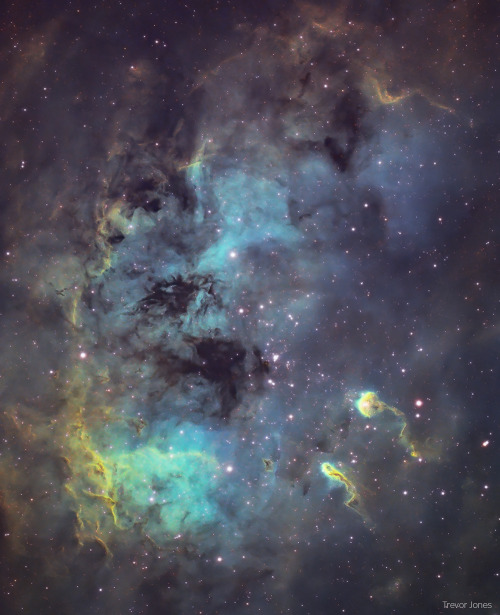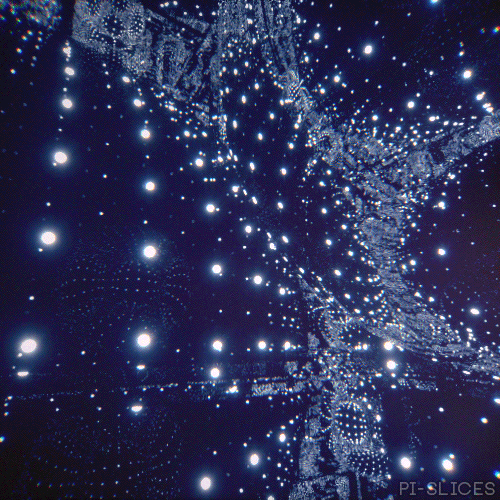Latest Posts by epic-flight - Page 4

Cesare Reggiani

Rainbow Mountains - 210526








Titan, moon of Saturn, observed by the Cassini space probe from 2004 to 2015.

The Sun photographed in a “specific red color of light emitted by hydrogen gas called Hydrogen-alpha and then color inverted to appear blue.” Courtesy of Alan Friedman (Averted Imagination). (NASA)

Hubble Sees a Star Called HBC 672 and the Bat Shadow : A young star’s unseen, planet-forming disk casts a huge shadow across a more distant cloud in a star-forming region. (via NASA)

Clouds, swimming in fractals 2021
new animated work!

: What is creating the structure in Comet NEOWISE’s tails? Of the two tails evident, the blue ion tail on the left points directly away from the Sun and is pushed out by the flowing and charged solar wind. Structure in the ion tail comes from different rates of expelled blue-glowing ions from the comet’s nucleus, as well as the always complex and continually changing structure of our Sun’s wind. Most unusual for Comet C/2020 F3 (NEOWISE), though, is the wavy structure of its dust tail. This dust tail is pushed out by sunlight, but curves as heavier dust particles are better able to resist this light pressure and continue along a solar orbit. Comet NEOWISE’s impressive dust-tail striations are not fully understood, as yet, but likely related to rotating streams of sun-reflecting grit liberated by ice melting on its 5-kilometer wide nucleus. The featured 40-image conglomerate, digitally enhanced, was captured three days ago through the dark skies of the Gobi Desert in Inner Mongolia, China. Comet NEOWISE will make it closest pass to the Earth tomorrow as it moves out from the Sun. The comet, already fading but still visible to the unaided eye, should fade more rapidly as it recedes from the Earth. via NASA





Allegiance-class Star Destroyer - Ansel Hsiao

The Sun, as of August 12, 2015.

Richard Bizley

Mountain Lake - 210408

The Tadpoles of IC 410 : This telescopic close-up shows off the central regions of otherwise faint emission nebula IC 410, captured under backyard suburban skies with narrowband filters. It also features two remarkable inhabitants of the cosmic pond of gas and dust. Below and right of center are the tadpoles of IC 410. Partly obscured by foreground dust, the nebula itself surrounds NGC 1893, a young galactic cluster of stars. Formed in the interstellar cloud a mere 4 million years ago, the intensely hot, bright cluster stars energize the glowing gas. Composed of denser cooler gas and dust, the tadpoles are around 10 light-years long and are likely sites of ongoing star formation. Sculpted by stellar winds and radiation their heads are outlined by bright ridges of ionized gas while their tails trail away from the cluster’s central young stars. IC 410 lies some 10,000 light-years away, toward the nebula-rich constellation Auriga. via NASA

Light Spheres - 210315
USS Harry S. Truman Strike Group Flyover
The U.S. Navy Flight Demonstration Squadron, the Blue Angels, flew over Nimitz-class aircraft carrier, USS Harry S. Truman (CVN 75), on a return transit to Naval Air Station Pensacola following their annual flight over the U.S. Naval Academy commissioning ceremony May 20, 2020. The Harry S. Truman Carrier Strike Group (HSTCSG) remains at sea in the Atlantic as a certified carrier strike group force ready for tasking in order to protect the crew from the risks posed by COVID-19, following their successful deployment to the U.S. 5th and 6th Fleet areas of operation. (U.S. Navy video by Petty Officer 2nd Class Cody Hendrix)

Unraveling.
Twitter / Instagram / Shop / Gumroad / Patreon / Zedge








Consolidator-class Corps Assault Ship - Ansel Hsiao

‘jump’

Shot by Ted Emmons

Orbiting - 210216


Art G.Shvecova (Design graphics - Blue Nebula_140318)
Black Holes: Seeing the Invisible!
Black holes are some of the most bizarre and fascinating objects in the cosmos. Astronomers want to study lots of them, but there’s one big problem – black holes are invisible! Since they don’t emit any light, it’s pretty tough to find them lurking in the inky void of space. Fortunately there are a few different ways we can “see” black holes indirectly by watching how they affect their surroundings.

Speedy stars
If you’ve spent some time stargazing, you know what a calm, peaceful place our universe can be. But did you know that a monster is hiding right in the heart of our Milky Way galaxy? Astronomers noticed stars zipping superfast around something we can’t see at the center of the galaxy, about 10 million miles per hour! The stars must be circling a supermassive black hole. No other object would have strong enough gravity to keep them from flying off into space.

Two astrophysicists won half of the Nobel Prize in Physics last year for revealing this dark secret. The black hole is truly monstrous, weighing about four million times as much as our Sun! And it seems our home galaxy is no exception – our Hubble Space Telescope has revealed that the hubs of most galaxies contain supermassive black holes.
Shadowy silhouettes
Technology has advanced enough that we’ve been able to spot one of these supermassive black holes in a nearby galaxy. In 2019, astronomers took the first-ever picture of a black hole in a galaxy called M87, which is about 55 million light-years away. They used an international network of radio telescopes called the Event Horizon Telescope.

In the image, we can see some light from hot gas surrounding a dark shape. While we still can’t see the black hole itself, we can see the “shadow” it casts on the bright backdrop.
Shattered stars
Black holes can come in a smaller variety, too. When a massive star runs out of the fuel it uses to shine, it collapses in on itself. These lightweight or “stellar-mass” black holes are only about 5-20 times as massive as the Sun. They’re scattered throughout the galaxy in the same places where we find stars, since that’s how they began their lives. Some of them started out with a companion star, and so far that’s been our best clue to find them.

Some black holes steal material from their companion star. As the material falls onto the black hole, it gets superhot and lights up in X-rays. The first confirmed black hole astronomers discovered, called Cygnus X-1, was found this way.
If a star comes too close to a supermassive black hole, the effect is even more dramatic! Instead of just siphoning material from the star like a smaller black hole would do, a supermassive black hole will completely tear the star apart into a stream of gas. This is called a tidal disruption event.
Making waves
But what if two companion stars both turn into black holes? They may eventually collide with each other to form a larger black hole, sending ripples through space-time – the fabric of the cosmos!

These ripples, called gravitational waves, travel across space at the speed of light. The waves that reach us are extremely weak because space-time is really stiff.
Three scientists received the 2017 Nobel Prize in Physics for using LIGO to observe gravitational waves that were sent out from colliding stellar-mass black holes. Though gravitational waves are hard to detect, they offer a way to find black holes without having to see any light.
We’re teaming up with the European Space Agency for a mission called LISA, which stands for Laser Interferometer Space Antenna. When it launches in the 2030s, it will detect gravitational waves from merging supermassive black holes – a likely sign of colliding galaxies!

Rogue black holes
So we have a few ways to find black holes by seeing stuff that’s close to them. But astronomers think there could be 100 million black holes roaming the galaxy solo. Fortunately, our Nancy Grace Roman Space Telescope will provide a way to “see” these isolated black holes, too.

Roman will find solitary black holes when they pass in front of more distant stars from our vantage point. The black hole’s gravity will warp the starlight in ways that reveal its presence. In some cases we can figure out a black hole’s mass and distance this way, and even estimate how fast it’s moving through the galaxy.
For more about black holes, check out these Tumblr posts!
⚫ Gobble Up These Black (Hole) Friday Deals!
⚫ Hubble’s 5 Weirdest Black Hole Discoveries
Make sure to follow us on Tumblr for your regular dose of space: http://nasa.tumblr.com.

Approaching Innsbruck
Nuclear Winter and the End of the Arms Race: Carl Sagan Interview (1991)
A powerful and prophetic interview, as always, with Professor Sagan. Contrary to the video’s title, topics discussed range from science education, nuclear disarmament, economics, and critique of America. Sagan responds to queries from callers.

Preparing for the approach

What we are doing while you sleep

Cosmic Debris.
You can get this GIF as a phone wallpaper for free through the Zedge app.
You can also get this GIF as a looping 1080p video if you support me on Patreon.
Twitter / Instagram / Shop / Gumroad / Patreon / Zedge





Perhonen Space Ship - Adrian Marc


